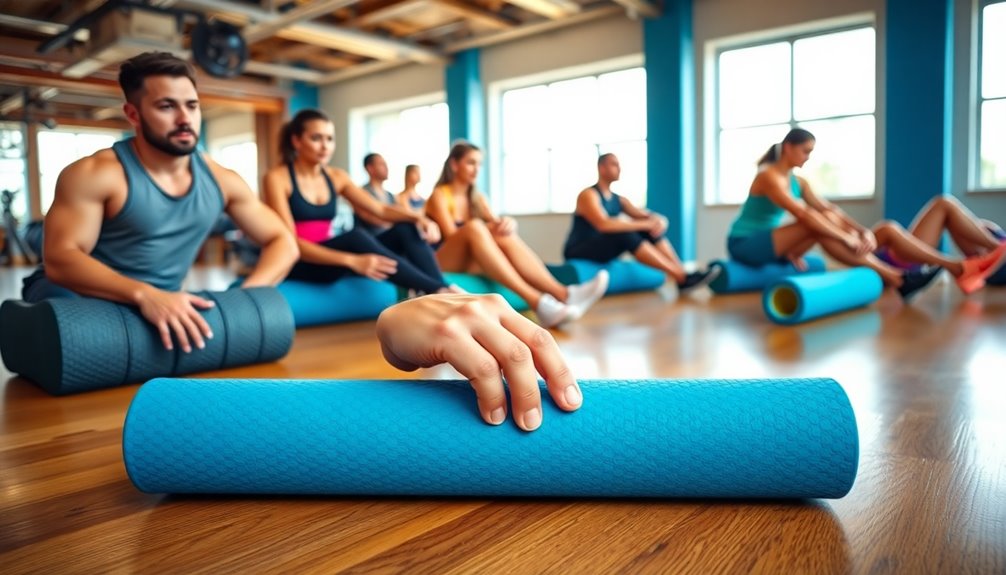Foam rollers are essential tools for enhancing muscle recovery, improving flexibility, and relieving stress. By applying pressure on your muscles and fascia, they help break down knots and improve circulation. Use them pre-workout to activate muscles or post-workout to ease soreness. Focus on tense areas with targeted techniques like cross-friction rolling and maintaining a steady rhythm. Avoid common mistakes like rolling too quickly or neglecting your form. Incorporating foam rolling into your routine can enhance your fitness results and elevate your well-being. Discover effective strategies and tips to maximize your foam rolling experience next!
Key Takeaways
- Foam rolling enhances muscle recovery by alleviating soreness and promoting relaxation through increased blood flow to tense areas.
- It improves flexibility and range of motion, making it beneficial for both pre-workout activation and post-workout recovery.
- Utilizing different techniques, such as targeted rolling and cross-friction rolling, maximizes the effectiveness of foam rolling sessions.
- Regular foam rolling can aid in injury prevention by breaking down muscle knots and improving muscle engagement.
- Incorporate foam rolling into rest days for active recovery, focusing on major muscle groups and areas of fatigue.
What Is a Foam Roller?
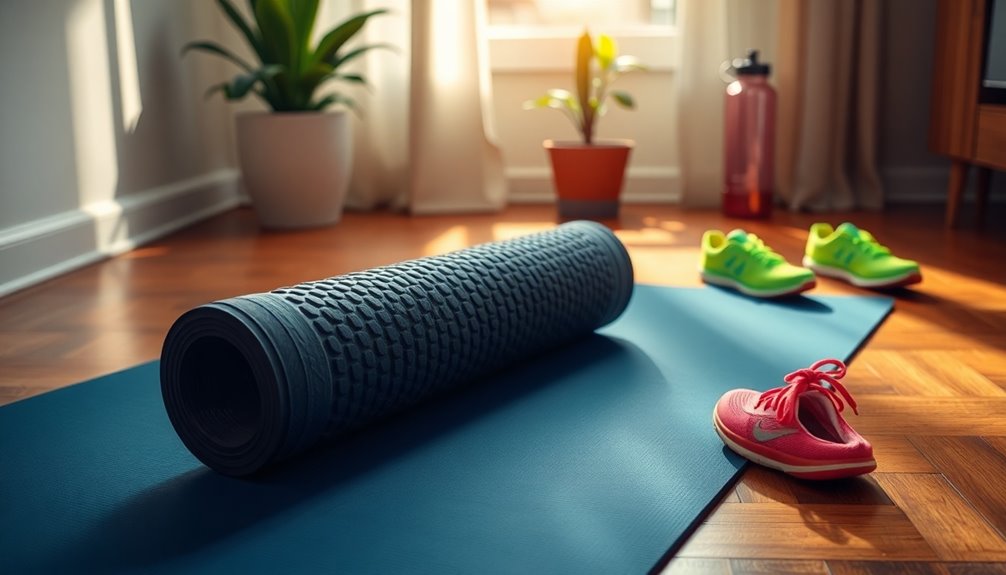
A foam roller is a cylindrical piece of foam that has become a staple in fitness and rehabilitation. You'll find various types, including the standard foam roller, textured rollers, and vibrating models, each offering unique benefits. The materials used range from soft, low-density foam to more rigid, high-density options, allowing you to choose one that suits your needs.
When you use a foam roller, employing proper technique is crucial to maximize its effectiveness. Begin by targeting specific muscle groups, such as your quadriceps, hamstrings, calves, and back. Each area benefits from different foam rolling exercises.
For example, rolling your calves involves positioning the roller under your lower leg while using your arms to lift your body and apply pressure.
Foam rolling for recovery is particularly beneficial after intense workouts, as it helps release tension and improve circulation. This method isn't limited to athletes; anyone involved in physical activity can take advantage of its benefits. Integrating foam rolling into your routine enhances flexibility and readies your muscles for the next workout. Additionally, using a foam roller can complement other fitness tools like mini bands, which offer unique benefits in muscle toning.
While delving into foam rolling, keep in mind that it's a practice embraced by many in the fitness community. Engaging in these techniques can cultivate a sense of belonging among fellow fitness enthusiasts. So, grab your foam roller and start rolling your way to improved recovery and performance!
Benefits of Foam Rolling
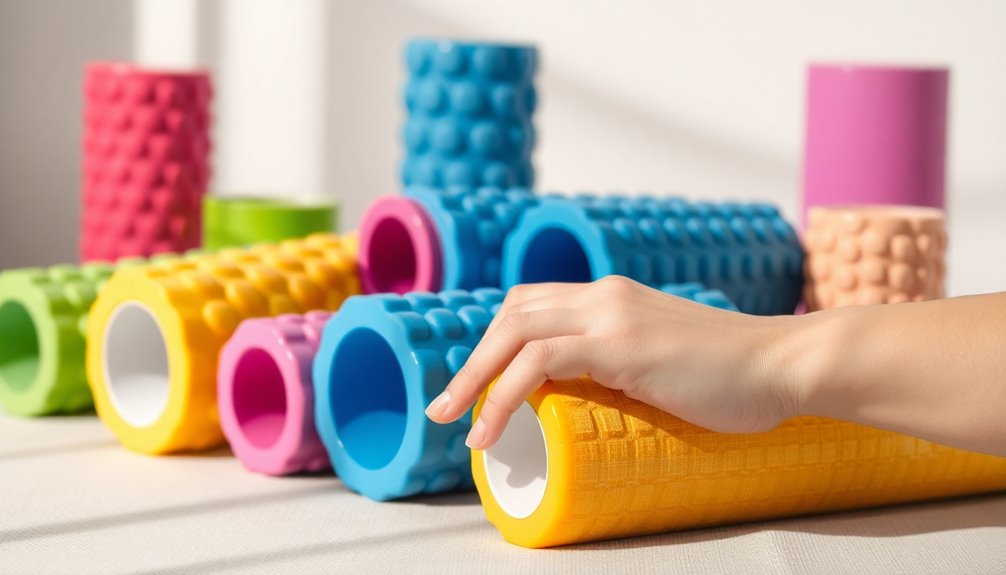
Foam rolling offers numerous benefits that can greatly enhance your fitness routine and overall well-being. By incorporating foam rolling into your regimen, you can experience improvements in muscle recovery, flexibility, and overall performance. Here's what you can look forward to:
- Enhanced Muscle Recovery: After a tough workout, your muscles may feel tight and sore. Foam rolling can help alleviate this discomfort by increasing blood flow and breaking down knots in your muscles. This promotes faster recovery, so you can get back to your routine more quickly.
- Improved Flexibility Training: If you're looking to boost your flexibility, foam rolling is a fantastic tool. By regularly using a foam roller, you can increase your range of motion, which is essential for effective stretching and overall mobility. This means you'll not only feel better during workouts but also reduce the risk of injury.
- Stress Relief: Foam rolling isn't just about physical benefits; it can also enhance your mental well-being. The act of rolling out your muscles can be meditative and provide a sense of relaxation. This can help you unwind after a long day, making it a great addition to your self-care routine. Additionally, combining foam rolling with a program like The Smoothie Diet can further enhance your recovery and overall health.
Incorporating foam rolling into your fitness journey fosters a sense of community and support. You're not just improving your own performance; you're also joining others who value recovery and flexibility as essential parts of a healthy lifestyle.
How Foam Rolling Works
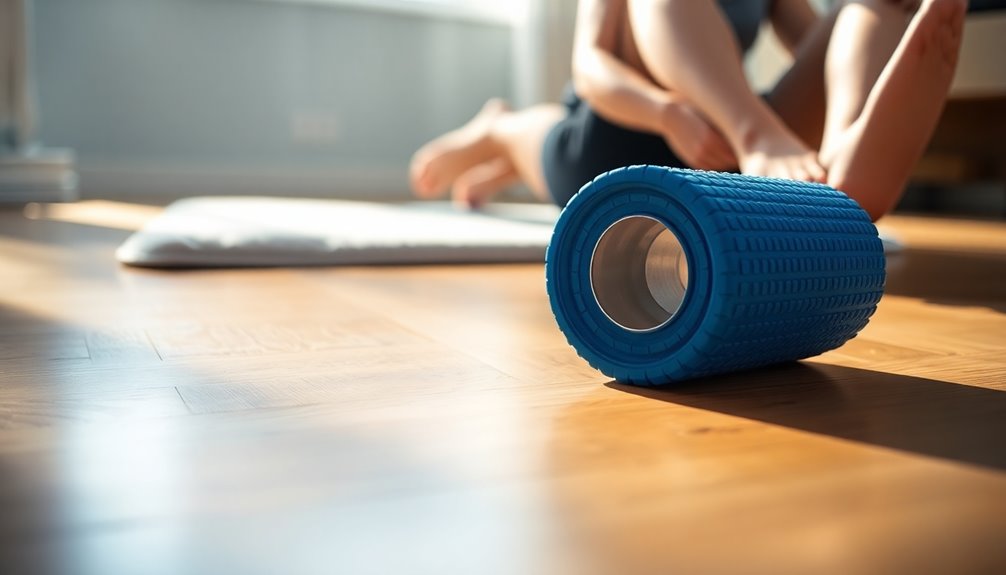
Understanding how foam rolling works is fundamental for maximizing its benefits. When you use a foam roller, you apply pressure to your muscles and fascia, which can lead to significant muscle relaxation. This self-myofascial release technique targets knots and tight spots within your muscles, breaking down adhesions and improving overall movement quality. By rolling over these areas, you activate the body's natural response to alleviate tension and discomfort, making your muscles more pliable.
Another vital aspect of foam rolling is its effectiveness in improving circulation. As you roll, you're not only relieving muscle tightness but also promoting blood flow to the affected areas. This increased circulation helps deliver essential nutrients and oxygen to your muscles, enhancing recovery after workouts and reducing soreness.
The combination of muscle relaxation and improved circulation can lead to a more effective and enjoyable workout experience. Additionally, incorporating dynamic exercises into your routine can further enhance your core strength and overall fitness level.
To get the most out of foam rolling, it's essential to learn proper techniques and focus on specific muscle groups that feel tight or sore. Spend extra time on these areas, but be mindful not to overdo it. You want to experience relief, not pain. By incorporating foam rolling into your routine, you'll foster a sense of belonging within the fitness community, as many individuals share the same journey toward better mobility and recovery.
Types of Foam Rollers
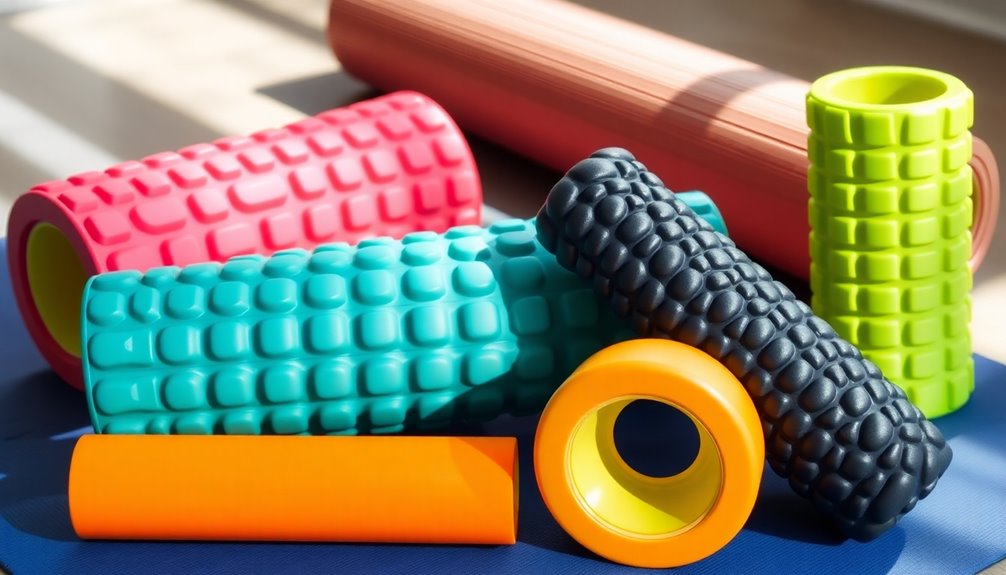
Choosing the right foam roller can significantly enhance your experience and results. With so many foam roller options available, it's vital to understand which one suits your needs best. Here's a quick overview of the three main types of foam rollers:
- Standard Foam Rollers: These are the most common and come in various densities. Ideal for beginners, they provide a gentle massage and are excellent for general muscle recovery.
- Grid Foam Rollers: With their unique textured surface, grid foam rollers target specific muscle groups more effectively. They're perfect for those seeking deeper pressure and a more intense rolling experience.
- High-Density Foam Rollers: These rollers are firmer and designed for serious athletes or anyone accustomed to foam rolling. They offer a deep tissue massage, helping to alleviate tightness in well-conditioned muscles.
When you invest in a foam roller, don't forget about foam roller maintenance. Regular cleaning is essential to guarantee longevity and hygiene. Simply wipe your roller down with a mild soap and water solution after each use and let it air dry. This simple practice will keep your roller in top shape, ready for your next session. Additionally, incorporating foam rolling into your routine can complement other health practices, such as supporting nerve health and overall recovery.
Techniques for Effective Foam Rolling
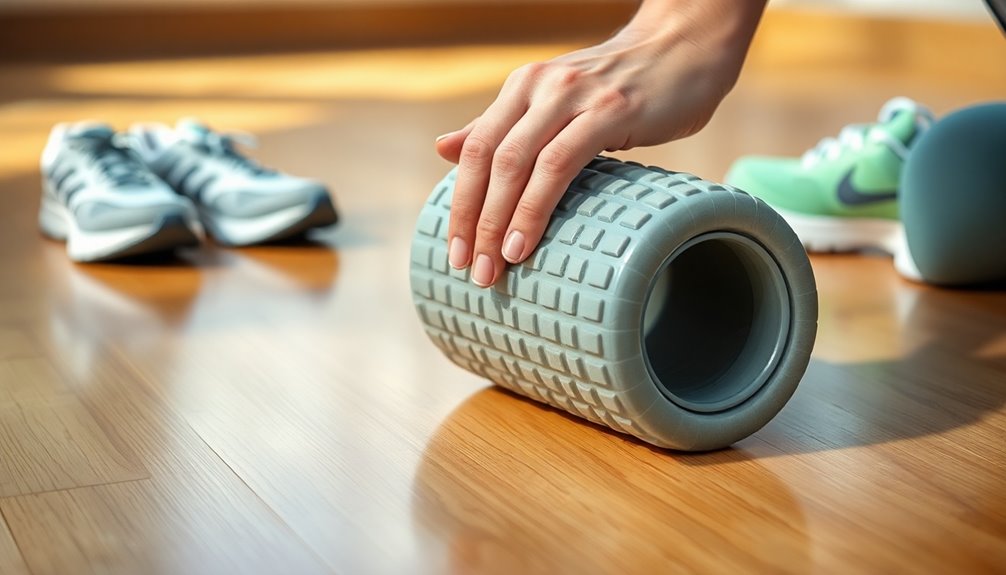
Once you've selected the right foam roller for your needs, mastering effective rolling techniques can maximize your benefits. Start with targeted rolling, focusing on specific muscle groups that feel tight or sore.
For instance, if your calves are tense, position the roller under your lower leg and gently roll back and forth. Aim to spend about 30 seconds to a minute on each area, applying just enough pressure to feel the tension release without causing pain.
As you become more comfortable, incorporate advanced techniques to deepen the effectiveness of your routine. One effective method is the "pause and breathe" technique. When you find a particularly tight spot, pause there and take slow, deep breaths. This helps relax the muscle and allows for greater release.
You can also try cross-friction rolling, where you move the roller perpendicular to the muscle fibers. This technique can be especially beneficial for larger muscle groups like your thighs or back.
Remember to maintain a steady rhythm while rolling. Avoid rushing through your routine; instead, focus on feeling the muscle release with each roll. Consistency is key, so aim to foam roll regularly, whether it's post-workout or on your rest days. Additionally, incorporating glute-specific movements into your routine can enhance overall muscle engagement and effectiveness of your foam rolling sessions.
Common Mistakes to Avoid
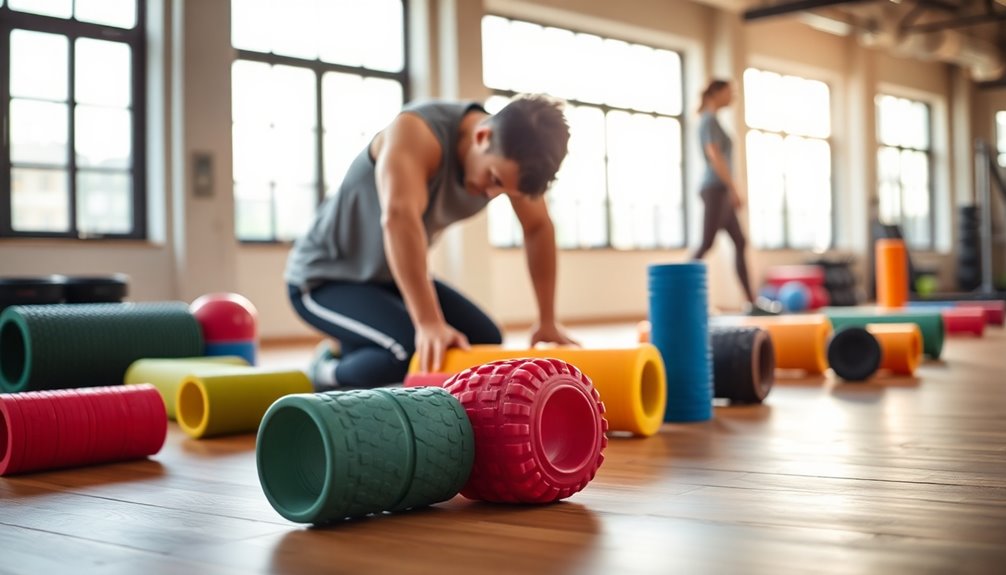
When foam rolling, avoiding these traps that can hinder your progress and even lead to discomfort is vital for maximizing the benefits of foam rolling and ensuring proper form, which is necessary for injury prevention. Here are three common pitfalls to watch out for:
- Rolling too quickly: Many people rush through their foam rolling sessions, thinking speed will yield better results. However, moving too fast can prevent the pressure from effectively releasing tension in your muscles. Instead, take your time, focusing on each area for about 30 seconds.
- Neglecting proper form: Another common mistake isn't maintaining proper form while rolling. If you're not positioned correctly, you can put unnecessary strain on joints or muscles, which may lead to injury. Always keep your body aligned and engage your core for stability.
- Overdoing it: While foam rolling can be beneficial, listening to your body is crucial. Rolling for too long or applying excessive pressure can cause bruising or soreness. Stick to a moderate intensity, and remember that foam rolling isn't meant to be painful. Additionally, incorporating effective warm-up routines can further enhance your muscle recovery and reduce the risk of injury.
Foam Rolling for Recovery

Foam rolling can be a game-changer for your recovery routine, helping to alleviate muscle soreness and improve flexibility. When you engage in foam rolling, you're promoting muscle relaxation, which is crucial after a tough workout. This technique allows you to target specific muscle groups, releasing tension built up during your training sessions. As you roll over those tight spots, you're also increasing blood flow, which aids in recovery and helps your muscles repair faster.
Incorporating foam rolling into your post-workout regimen has significant mobility benefits. By regularly using a foam roller, you're not just addressing soreness; you're actively preventing injuries. Improved flexibility means your muscles can move through a broader range of motion, which is essential for both athletic performance and everyday activities. The more mobile you are, the less likely you're to strain or injure yourself.
Make foam rolling a priority in your recovery routine. Start with just a few minutes daily, focusing on areas that feel particularly tight or sore. Gradually, you'll notice that your muscles begin to feel more relaxed, and your overall flexibility improves. This practice not only enhances your physical performance but also fosters a sense of belonging within your fitness community, as you share tips and experiences with fellow enthusiasts. Embrace foam rolling as a crucial tool in your journey towards better recovery and overall well-being, as it aligns with methods used in programs like Adaptive Body Boost that emphasize effective recovery strategies.
Incorporating Foam Rolling Into Routine
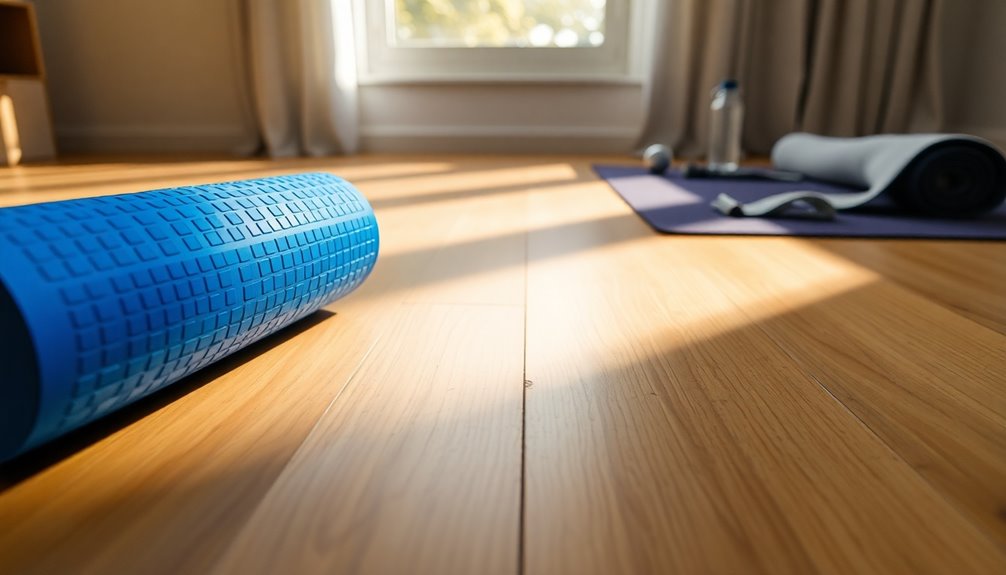
Integrating foam rolling into your fitness routine can greatly enhance your overall performance and recovery. By making foam rolling a part of your daily routine, you'll not only improve your flexibility but also aid in body maintenance, ensuring you stay in peak condition. Here are three practical ways to incorporate foam rolling into your lifestyle:
- Pre-Workout Activation: Spend 5-10 minutes foam rolling before you start your workout. Focus on major muscle groups like your quads, hamstrings, and back. This helps warm up your muscles and prepares them for more intense activity.
- Post-Workout Recovery: After you finish exercising, take another 5-10 minutes to foam roll. This will help reduce muscle soreness and tightness, promoting quicker recovery. Aim for areas that feel particularly tense or fatigued.
- Rest Days: On your rest days, dedicate some time—perhaps 15-20 minutes—to foam rolling. This can serve as a form of active recovery, keeping your muscles engaged while still allowing for healing. It's an excellent way to prioritize body maintenance during downtime.
Frequently Asked Questions
Can Foam Rolling Help With Muscle Soreness After Workouts?
Yes, foam rolling can definitely help with muscle soreness after workouts. It acts as a recovery aid, promoting blood flow and reducing tightness in your muscles. By incorporating foam rolling into your routine, you'll experience post workout relief that aids in quicker recovery times. Just roll over sore areas for a few minutes, and you'll feel the difference.
Embracing this technique can be a game-changer for your fitness journey, helping you recover and stay engaged.
Is Foam Rolling Safe for Everyone, Including Beginners?
Foam rolling can be a journey, much like a river flowing through varied terrain. It's generally safe for everyone, but you should listen to your body. If you're a beginner, consider foam rolling modifications to ease into it.
There are also foam rolling alternatives, like massage balls or gentle stretches, that can help you find comfort. By taking it slow and adjusting as needed, you'll create a practice that feels right for you.
How Often Should I Use a Foam Roller?
You should aim for foam rolling frequency of at least two to three times a week. Each session can last about 10 to 15 minutes, focusing on areas that feel tight or sore.
Listen to your body; if you're feeling particularly tight after workouts, you might benefit from more frequent sessions.
Consistency is key, so make foam rolling a part of your routine to enhance your recovery and overall mobility.
Can Foam Rolling Improve Flexibility and Range of Motion?
Think of your muscles like a tightly wound rubber band; foam rolling can help loosen them up.
By promoting myofascial release, you'll see flexibility improvement and an increased range of motion. This technique not only aids in recovery but also plays a vital role in injury prevention.
When you incorporate foam rolling into your routine, you're investing in your body's performance, making it easier to move freely and enjoy your activities to the fullest.
What Should I Do if I Feel Pain While Foam Rolling?
If you feel pain while foam rolling, it's important to listen to your body. Pain management starts with gentle pressure; consider using lighter foam rollers or softer surfaces.
You can also make modifications for beginners, like rolling smaller muscle groups or adjusting your position to relieve pressure. Don't hesitate to stop if the discomfort persists.
Conclusion
Incorporating foam rolling into your routine is like tuning a musical instrument; it harmonizes your body and enhances performance. By regularly using a foam roller, you smooth out the knots and tension, creating a symphony of movement that feels effortless. Embrace this simple yet powerful tool, and watch as your recovery and overall well-being improve. Just as a well-tuned instrument plays beautifully, a well-cared-for body performs at its best. Don't miss out on this transformative practice!

